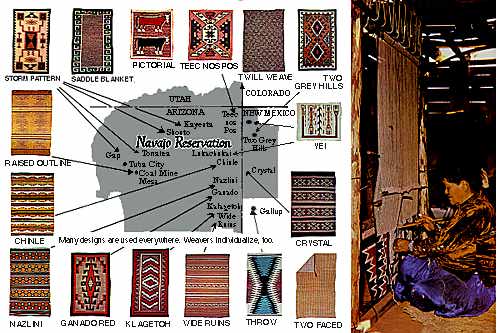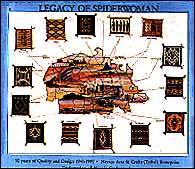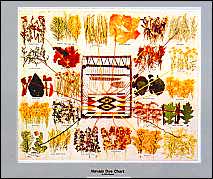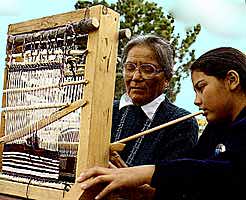NAVAJO
RUGS: STYLES ON THE RESERVATION

|
The map, showing where different designs of rugs were produced at different communities on the Navajo reservation, was prepared by the late Tom Bahti, in a large-format bookfirst printed in 1966, and reprinted many times thereafter. Bahti was a longtime dealer and collector of Indian art, and a recognized expert. His several books, beautifuly illustrated were among the best of their time.
Several things are noteworthy about this ca. 1966 map. First, through a land claims process, the reservation's boundaries now extend a considerable distance to the east in New Mexico. Second, the several "utility" blankets (formerly used personally for saddle blankets, and home use) are no longer made; they are too much work, and collector-tourists don't want them. Third, pictorials are fancier now, less cartoonish, and more Indian in pictorial design. Fourth, there are now many more "Yeibichai" or so-called ceremonial souvenir small rugs, and some that mimic sand paintings. Though none of these are authentic -- the designs are inspired by the ceremonial processes, they don't copy them -- they are very popular with tourists. Originally, there was some opposition to these designs from traditional elders; this seems now to have disappeared. Rug designs sometimes have names (like the Storm pattern) and perhaps have inner meanings for the weavers. But the designs themselves are not symbolic, they have no significance. Although elements of sandpaintings and yeibichai dancers' regalia are used on the so-called ceremonial rugs, the rugs and the designs seen there are not used in any Navajo rites or ceremonies. " Ceremonial" is strictly a commercial category for certain design types. You can see current design differences -- and get a nice-looking, inexpensive poster for classroom or home -- in a modern poster, that uses photos of small rugs woven by Navajo Lula Brown, and artwork by Benson Harwood. This shows the reservation's outline filled in with Harwood's evocative pantings, overlaid with modern roads, a great many more communities than there were in the 1960's. Rug designs now are quite different from these older ones Bahti recorded (even if their names are the same). Bahti does say that individual artists did many variations, but the fact is that designs are no longer standardized as they were in the days when traders almost entirely controlled weavers' outputs.
These rug designs -- like the process of weaving -- postdate the Spanish introduction of fine merino sheep (all of which were killed in the period of the forcced death marches to Bosque Redondo). When U.S. traders settled in various isolated outposts on the reservation, they and certain collectors financially enforced certain styles. Some of these were good -- the use of traditional plant dyes, rather than harsh commercial chemical dyes -- but there was also considerable rigidity about what the trader would accept in the way of designs -- the ones known to please large buyers. As local governance and on-reservation financial control of Native arts and crafts marketing has gradually strengthened, rug weavers now have more freedom to take inspiration from the land, plants, skies, and their colors. Too, easier travel and better communication means that patterns traditionally associated with specific locations are seen and can be learned by weavers all over the reservation.
Weaving takes a long time, and it takes about as long, again, to prepare, spin, and dye the wool. Only pure wool is used for authentic rugs; those with cotton wefts are made for tourists. In addition to the continuing art of rug-weaving, the Navajo Nation maintains a mill and a factory that produces inexpensive wearing blankets (often seen at powwows) in several patterns. Hand-woven, hand spun and dyed shawls and men's serapes so tight they are waterproof are still highly desired (and expensive) for gifts. that will last and be both beautiful and useful nearly forever -- just like the best rugs. A 3 x 5' rug takes about 350 hours of work (if wool and yarn preparation is also involved), and longer if plant and mineral dyes are prepared and used. Handspun yarn gives these rugs strength and durability -- perceptible as part of their beauty -- far beyond what is obtainable by commercial mechanized processes for any part of the weavers' arts. Here are a few examples of Navajo rugs -- some current contemporary and some dating from the 1920's and /'30's:
|
|---|
Page |
Menu |
Menu |
|---|
|
Text, maps and graphics copyright -- Paula Giese, 1996. except where elsewhere attributed. CREDITS:Rugmap: Tom Bahti. Photography by K. Camille den Dooven, Southwestern Indian Arts and Crafts, K.C. Publications, c. 1966, 7th reprinting, 1977. The two posters are scanned from the Toh-Atin current catalog. Photo of Ruth and Jaclyn Roessel weaving, is scanned from Monty Rossel's book. part of Lerner's "We're Still Here" series of true stories written and photographed by Native authors. |

 The handsome modern poster -- celebrating the 50th anniversary of Navajo Arts and Crafts Tribal Enterprise -- is available from Toh-Atin Gallery (that's a Navajo word meaning "No water") for $10. Its title is "The Legacy of Spider Woman.." Toh-Atin has another $7 poster by Navajo weaver Ella Myers nice for classroom use that shows the plants used for wool dyes, where they grow on the big reservation, how the dyes are made, and what colors result. The plants are "mapped" onto a rug-in-progress. Toh-Ahtin's phone is 800/525-0384. They have catalogs of a great many signed and numbered prints by many well-known Indian artists' (price range $50-$200), and some economical posters -- for things like Indian foods, as well as announcements of art exhibitions. Toh-Ahtin does its own quality printing (supervised by the artists) of original-multiples, and of prints.
The handsome modern poster -- celebrating the 50th anniversary of Navajo Arts and Crafts Tribal Enterprise -- is available from Toh-Atin Gallery (that's a Navajo word meaning "No water") for $10. Its title is "The Legacy of Spider Woman.." Toh-Atin has another $7 poster by Navajo weaver Ella Myers nice for classroom use that shows the plants used for wool dyes, where they grow on the big reservation, how the dyes are made, and what colors result. The plants are "mapped" onto a rug-in-progress. Toh-Ahtin's phone is 800/525-0384. They have catalogs of a great many signed and numbered prints by many well-known Indian artists' (price range $50-$200), and some economical posters -- for things like Indian foods, as well as announcements of art exhibitions. Toh-Ahtin does its own quality printing (supervised by the artists) of original-multiples, and of prints.  Round Rock Navajo elder Ruth Roessel teaches grandaughter Jaclyn to weave. "This is who we are," Grandmother Ruth said. "The loom connects me with the sacred mountains, and a song connects me with my mother." As long as she has her loom, Grandma Ruth says, she is home in Dine Bekayah. Photographed by Monty Roessel for his book Songs from the Loom: A Navajo Girl Learns to Weave, Lerner Publications, Minneapolis: 1995.
Round Rock Navajo elder Ruth Roessel teaches grandaughter Jaclyn to weave. "This is who we are," Grandmother Ruth said. "The loom connects me with the sacred mountains, and a song connects me with my mother." As long as she has her loom, Grandma Ruth says, she is home in Dine Bekayah. Photographed by Monty Roessel for his book Songs from the Loom: A Navajo Girl Learns to Weave, Lerner Publications, Minneapolis: 1995.